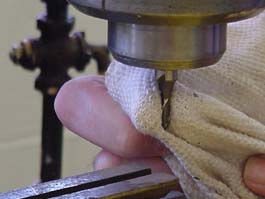Using the Vertical Milling Machine
Controls: The controls on the vertical milling machine in the materials processing laboratory consist of the following:
- A magnetic power switch that must be reset if the power in the laboratory is interrupted.
- A spindle break so that the spindle nut can be loosened to take the collet out of the chuck.
- A quill feed handle to manually feed the cutter into the stock.
- A quill lock to lock the cutter in place.
- A longitudinal feed screw handle to move the stock into the cutter on an x-axis.
- A cross feed screw handle to move the stock into the cutter on a y-axis.
- A knee height adjustment screw to position the depth of the cut.
- A high and low speed clutch knob.
- A back gear control knob.
- A power feed engagement knob.
- A manual feed knob.
- A feed control knob.
- A quill feed selector knob.
- A draw bar knob.
Operation (Drilling): Milling is the operation during which the stock is moved into the cutter on an x, y or z-axis to remove stock. All the operations that are described on this sheet are using a manual feed. Refer to the following illustrations.
- Select the proper cutting bit.
- Place the bit in the spindle and make sure that the bit is at a right angle to the table.
- Tighten the spindle using the nut on the top of the milling machine.
- Place the stock in the vise and lock it in place.
- Make sure that the vise is tight and holding the material securely by hitting the handle with a rubber mallet.
- Position the cutter at the starting point.
- Place a spot of cutting oil on the spot that is to be cut.
- Select the right cutting speed, rpm, and rate of feed for the job.
- Cut the stock using the cross feed or longitudinal feed controls.
- Turn off the machine before removing the stock.
 |
|
| Make sure to use a rag to remove cutters from the chuck because the cutters are sharp. | Make sure to hammer the vise handle so that the vise is nice and tight. |
Potential hazards: Because of the rapid spinning motion of the milling cutter, the following hazards exist.
- Any body contact with the moving cutter will cause severe injury.
- Clothing or other articles that contact the moving cutter could become entangled and pull the operator into the cutter.
- The work piece can come loose from the vise if it is not tightened properly and do damage to the cutter and the operator.
- Small pieces of metal chips can be thrown out at the operator.
- The operator could slip and fall into the cutter.
- The cutter and the worker piece can become very hot.
- Be sure to perform only operations you know how to do safely.
- Always wear safety glasses.
- Never wear cloths or other articles that dangle and could catch on the cutter.
- Be sure to have firm footing.
- Check the machine to make sure it is in good working order.
- Wipe up any oil that is on the floor around the machine.
- Be certain that the table is clean and dry before making a setup.
- Always make sure that work holding devices such as a vise, angle plate, dividing head, or tail stock are fastened tightly to the table.
- Select the right kind of cutter for the job.
- Make sure that the machine is turned off when putting in a cutter.
- Always make sure that the arbor, cutter, and collars are clean before mounting them in the spindle.
- Use a rag to handle sharp cutters.
- Use a rubber hammer to set the work piece in the vise securely.
- Be certain that the vise or other holding devices clear the arbor and the overarm supports.
- Select the proper cutting speed, rpm, and rate of feed for the job.
- Disengage the control handles when using automatic feeds.
- Keep hands away from the revolving cutter at all times.
- Clear chips away from the cutter with a brush.
- Release any automatic feeds after the job is complete.
- Do not allow unauthorized persons within the safety zone of the machine.
- Clean and wipe the machine when the job is finished.
- Never touch the metal chips with your fingers.
Feeds and speeds chart for the verticle milling machine
References:
Johnson, Harold V. (1973). Technical Metals. Chas A. Bennett Co., Inc. Peoria, Illinois.
Repp, Victor E. (1994). Metalwork: Technology and Practice. Glencoe Macmillan/McGraw-Hill. New York, New York. 9th edition.
ITT 252 - Materials Processing
Department of Technology
University of Southern Maine
Prepared by Amy Ouellette, 11/6/01
